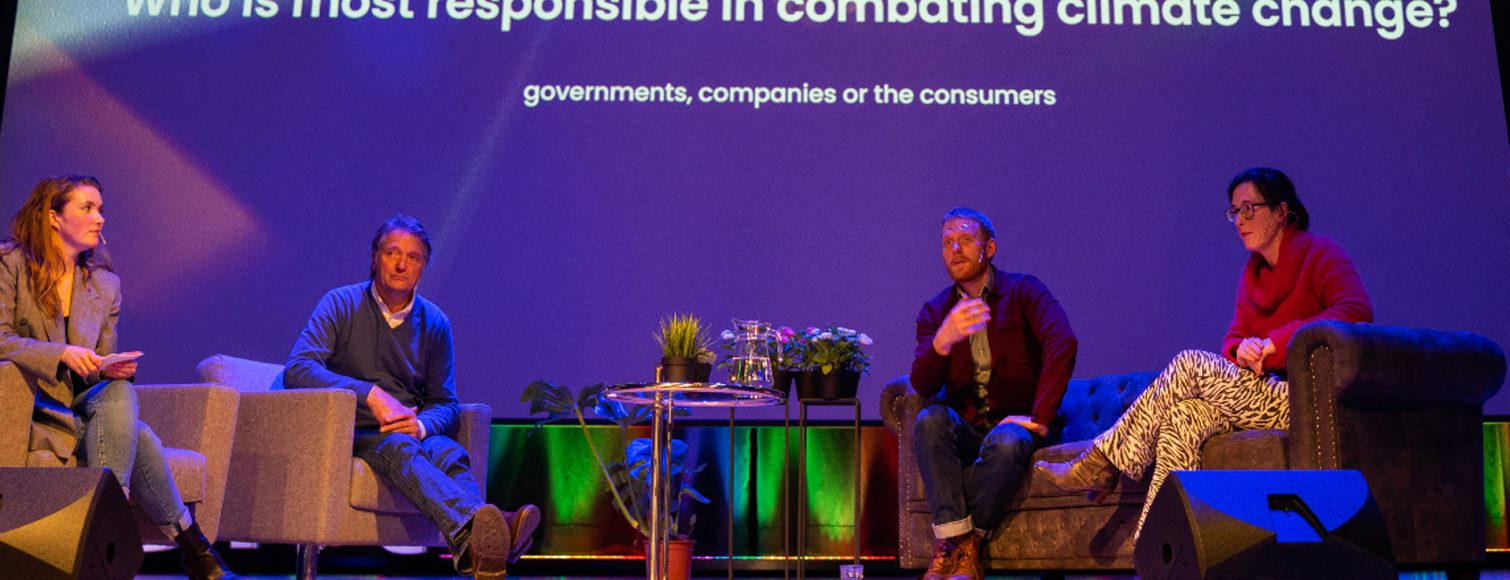by guest columnist Mark Musa Mitrani (BSc Computer Science).
The 10th installation of the annual Students4Sustainability symposium took place on the 21st of March, 2023. Three speakers tackling climate change with their own, unique approaches gave talks to explore the theme “Diverging Perspectives”, followed by a panel discussion led by the host. Were the talks as diverse as the theme suggests? Want to find out what you missed? This article summarizes key facts and offers the perspective of an attending student.
Circularity in a Toxic Industry
The first speaker was Bert van Son, the CEO of MUD Jeans. Having spent 40 years in the fashion industry, he saw how it “went downhill” in terms of sustainability: he gave us examples of such disturbing facts as a garbage truck full of clothes being dumped every second due to fast fashion practices. Bert founded MUD Jeans with the mission of creating a sustainable jeans company.
Bert gave insights into how his company makes fashion sustainable while delivering quality products. This includes material-related techniques such as using a less toxic dye to achieve the distinguished indigo color of denim and using 40% recycled cotton in the production of jeans, but also larger-scale principles such as circularity by design and outsourcing labor to ethical factories.
But while Bert’s talk was informative about how MUD Jeans practices sustainability, it would’ve been helpful to connect the message to the larger issue of sustainability in the fashion industry. A question that remains unanswered is how fast fashion companies can become less wasteful and more ethical.
Empowering Women in the Energy Transition
The next speaker was Anouk Creusen, the executive director of 75inQ. 75inQ is an organization whose mission is to “accelerate the energy transition by bringing gender balance to the table”. This mission was also the theme of her talk. Personally, Anouk’s insights were the most influential for me, as she was addressing a much-overlooked issue: the connection between gender inequality and sustainability. Showing a visualization of the interconnectedness of Sustainable Development Goals, Anouk points to a lack of connection between SDG’s 5 (Gender Equality) and 7 (Affordable and Clean Energy), as well as goals 5 and 13 (Climate Action). Instead of interpreting this as an indicator of non-relatedness, Anouk took on the challenge of identifying the ways in which these goals do relate to each other.
Among her findings is the fact that females are largely underrepresented in policy-making leadership, where women are involved in making 20% of the decisions. There is also a similar gender gap within the energy sector.
There are reasons why this gap needs to be addressed that go beyond the principle of gender equality. Female representation is critical since there are consequences of climate change that affect women more than men. Take women in developing countries, for instance: climate change forces migration, and women are more likely to be left behind during this process than men. The ones left behind are more prone to violence, and end up taking on more work, which is usually unpaid- these are just a few of the ensuing difficulties.
“Electrify your life” – Action-backed Hope for Climate Change
The final speaker was Paul Behrens, a climate scientist. His talk also offered interesting facts while motivating us to remain hopeful about our individual impact on the direction of climate change.
Although he did start by showing how scientists have realized they’ve underestimated the potential effects of climate change, he also made it clear that there is more support for environmental change than people think: in a study done in the UK, people were asked first how supportive they were of sustainability policies, and then for how supportive they thought others were- the results showed that the actual backing for environmental change is higher than the amount perceived by people.
Therefore, our main task as individuals is to remain vigilant and not let despair drive us to inaction. “Every action matters, every bit of warming matters, every year matters, every choice matters”, says Paul, emphasizing the importance of every single step moving forward. He also mentions different ways to get involved: “Go renewable, electrify your life, go plant-based, get engaged, get talking”. He wants to build hope not from optimism, but from action. According to Paul, individual change leads to collective change, and individuals pushing for systemic change can make a big difference, which is why we as individuals should not stand still just because some of our institutions might. “Things change quickly”.
Panel Discussion & Concluding Remarks
The talks were followed by a panel discussion which consisted of three rounds of questions that were answered by each speaker. This discussion was a memorable conclusion to the event which allowed us to see how the different perspectives come together. All in all, the 10th installation of the Students4Sustainability symposium demonstrated the power of converging diverse approaches in addressing climate change. From Bert van Son’s practical insights on how to create a sustainable fashion company to Anouk Creusen’s advocacy for gender balance in policy making and the energy sector, and Paul Behrens’ call for individual action towards systemic change, the symposium showcased the importance of bringing together different ideas and approaches in tackling this urgent global challenge. It’s clear that while there are differing approaches to tackling climate change, the ultimate goal of a sustainable future is a shared one just the same.
Personally, I appreciated Anouk’s and Paul’s talks the most. The former for her unique perspective, the latter for a well-informed, hopeful, big-picture overview. Furthermore, my time at the event was made more enjoyable thanks to the warm, relaxed environment that was established by the hosts. However, more time could’ve been allocated for questions from the audience after each speaker to make it more interactive.

